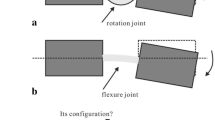Abstract
This article is supposed to serve as a guide for the design of flexure hinges that act as rotational joints. Firstly, flexure hinges with concentrated and distributed compliance are reviewed. They can be modeled by linear beam theories or by the theory of Elastica, respectively. Secondly, the transition between these limit cases is investigated by finite element methods (FEM). A planar symmetric flexure hinge with a circular notch serves as an exemplary geometry. By extending the notch the compliance is distributed. The deflection curves and the kinetics of desired and parasitic motions are chosen as key features to be studied. The corresponding results are compressed into a pseudo-rigid-body model (PRBM) approximation for a range of geometries. It turned out that the concentrated compliance matches best with an ideal rotational joint, but even for small displacements large stresses occur so that its range of operation is small. Distributing the compliance increases the range of operation, however stiffness within the task space decreases dramatically so that the design of a flexure hinge becomes a tradeoff between the two concurring goals large stiffness and large range of operation.
Zusammenfassung
Dieser Artikel soll als Richtlinie für den Entwurf elastischer Festkörpergelenke dienen, welche als Rotationsgelenke fungieren. Zunächst werden Festkörpergelenke mit konzentrierten und verteilten Nachgiebigkeiten einzeln betrachtet. Diese können mittels linearer Balkentheorie beziehungsweise mit der Theorie der Elastica modelliert werden. Anschließend wird der Übergang zwischen beiden Grenzfällen mit Hilfe von Finite-Elemente-Methoden (FEM) untersucht. Als beispielhafte Geometrie dient hierbei ein planares symmetrisches Festkörpergelenk mit einer Kreiskerbe. Durch Verlängerung der Kerbe wird die Nachgiebigkeit verteilt. Die Kinematik, insbesondere in Bezug zur Kreisbewegung eines idealen Drehgelenks, und die Stefigkeiten, sowohl der Sollbewegung als auch gegenüber Störkräften, werden als Hauptmerkmale für die Untersuchung gewählt. Die entsprechenden Ergebnisse werden als Pseudo-Starrkörpermodell für eine Auswahl von Geometrien zusammengefasst. Es stellte sich heraus, dass eine konzentrierte Nachgiebigkeit am besten zu einem idealen Rotationsgelenk passt, allerdings treten bereits bei kleinen Auslenkungen große Spannungen auf, so dass der Arbeitsbereich klein ist. Die Ausdehnung der Nachgiebigkeit vergrößert zwar den Arbeitsbereich, jedoch sinkt die Steifigkeit im Arbeitsraum dramatisch ab, so dass der Entwurf eines elastischen Festkörpergelenks zu einem Kompromiss zwischen den zwei gegensätzlichen Zielen einer hohen Steifigkeit und einem großen Arbeitsraum wird.












Similar content being viewed by others
References
Wulfsberg J, Redlich T, Kohrs P (2010) Prod Eng
Howell L (2001) Compliant mechanisms. Wiley-Interscience, New York
Mattson C, Howell L, Magleby S (2004) J Intell Mater Syst Struct 15(3):195
Ishii Y, Thümmel T, Horie M (2005) Microsyst Technol 11(8):991
Love A (1944) A treatise on the mathematical theory of elasticity. Dover Publications, New York
Howell L, Midha A (1995) J Mech Des 117(1):156
Dado M (2001) Int J Non-Linear Mech 36(7), 1123
Kimball C, Tsai L (2002) J Mech Des 124:223
Lobontiu N (2003) Compliant mechanisms: design of flexure hinges. CRC, Boca Raton
Tseytlin Y (2002) Rev Sci Instrum 73(9):3363
Lobontiu N, Paine J, O’Malley E, Samuelson M (2002) Precis Eng 26(2):183
Lobontiu N, Garcia E (2003) Comput Struct
Lobontiu N, Garcia E, Hardau M, Bal N (2004) Rev Sci Instrum
Chen G, Shao X, Huang X (2008) Rev Sci Instrum
Noda NA, Takase Y (2003) Eng Fract Mech
Zelenika S, Munteanu M, De Bona F (2009) Mech Mach Theory 44(10):1826
Yong Y, Lu T, Handley D (2008) Precis Eng 32(2):63
Ryu J, Gweon D (1997) Precis Eng 21(2):83
Kaufman J (2008) Properties of aluminum alloys: fatigue data and the effects of temperature, product form, and processing. ASM International, Russell Township
Deuflhard P, Hohmann A (2008) Numerische Mathematik I. de Gruyter, Berlin
Dirksen F, Lammering R (2011) Mech Sci 2
Smith S (2000) Flexures: elements of elastic mechanisms. CRC, Boca Raton
Acknowledgements
Financial support from the German Research Foundation (DFG) Priority Programme 1476 Small machine tools for small work pieces is gratefully acknowledged.
Author information
Authors and Affiliations
Corresponding author
Rights and permissions
About this article
Cite this article
Kern, D., Rösner, M., Bauma, E. et al. Key features of flexure hinges used as rotational joints. Forsch Ingenieurwes 77, 117–125 (2013). https://doi.org/10.1007/s10010-013-0169-z
Received:
Published:
Issue Date:
DOI: https://doi.org/10.1007/s10010-013-0169-z




